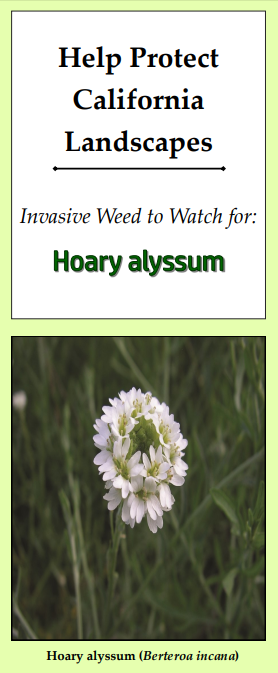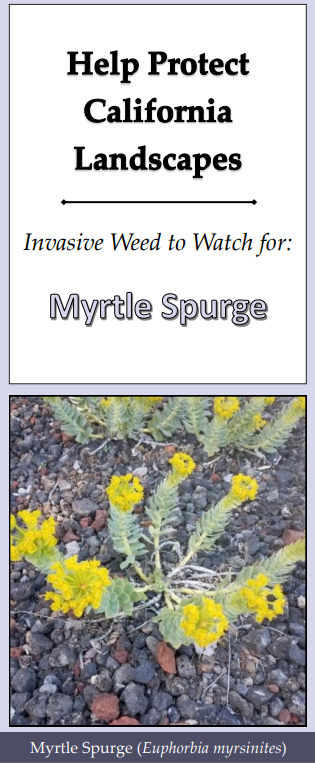Invasive Weeds
What You Can Do about Invasive Weeds
Invasive weeds are everyone's responsibility, and we need your help to eradicate them. Here are some steps you can take to help combat invasive weeds.
Prevent
- Many plants that seem desirable in gardens or landscaping share characteristics common in invasive plants, so be careful when buying new plants to check if that plant may be invasive in your area. Check out the Don't Plant a Pest brochure below for more information on good alternatives to popular invasive ornamentals.
- Seek planting advice from the Master Gardeners or the California Native Plant Society on the best plants for your area, and which plants to avoid.
- Seeds can be carried long distances by hitching a ride on your clothes, boots, tires, pets, vehicle undersides, etc. So be sure to check your clothes, animals, and belongings before leaving an area to avoid introducing new and potentially harmful species as you travel.
- Many invasive species thrive in disturbed soil, so give them some competition. Revegetate bare and disturbed areas with native plants before they have a chance to be taken over.
Identify
- Check out the brochures below to learn about invasive weeds, what they look like, and how to tell them apart from natives.
- Use a plant identification app to identify weeds from a picture. iNaturalist, PlantSnap, or PictureThis are just a few of the many apps available to help you do this.
- Ask a Master Gardener for identification help. Contact them via the Master Gardeners website, or collect a sample and bring it to their office at 311 Fair Lane in Placerville, UCCE Counter.
- Take advantage of these resources to be as accurate as possible in your identification, as some invasive species may have native lookalikes that should not be disturbed.
Report
- You can report the locations of invasive weeds on the Calflora website or by using the Calflora Observer Pro app, available for Android or Apple.
- You can explore the Calflora website and Observation Search to see other sightings of both native and invasive plants. Filter by County, plant name, or native versus invasive status.
- Reporting invasive weeds helps researchers and weed crews track the spread of invasive weeds, evaluate the threat, and prioritize their resources to be as effective as possible.
Removal and Treatment
- Information on the most effective control methods for specific weeds is available on the Cal IPC website. Select your invasive weed, then go to Weed Management Notes for information on various chemical and non-chemical control methods.
- Certain pesticides recommended for chemical control may require an Operator ID/Spray Permit to purchase. If you need an Operator ID, please call the Ag Department at (530) 621-5520 to schedule an appointment with a biologist to go over the requirements and obtain a permit. Getting a Spray Permit is free in El Dorado and Alpine Counties. Permits must be renewed annually and expire every year on December 31st.
- Please note: some recommended pesticides such as 2,4-D are restricted materials in California and are only available with a Restricted Materials Permit, which must meet stricter criteria than a standard Operator ID.
- For woody stemmed weeds such as Scotch Broom, you can borrow a weed wrench from the Department of Agriculture. There is no fee for renting a weed wrench, although there is a $50 refundable deposit. Weed wrenches are available in several sizes to suit your needs.
Continued Vigilance
- After removing invasives, revegetate the land so they have some competition, then monitor for sprouts and regrowth.
- Infestations of invasive weeds usually take several treatments over multiple years to remove.
- Many invasives can regenerate after mowing or hand pulling if part of the plant or root remains. They can have seeds that lay dormant for several years, and seeds may continue to spread from neighboring properties. Invasive weeds can also develop pesticide resistance, making them even harder to control.
Brochures
Weeds to Watch Out For
 (PDF, 903KB)
(PDF, 903KB)  (PDF, 1MB)
(PDF, 1MB)  (PDF, 1MB)
(PDF, 1MB)  (PDF, 1MB)
(PDF, 1MB)  (PDF, 1MB)
(PDF, 1MB)  (PDF, 1MB)
(PDF, 1MB)  (PDF, 1MB)
(PDF, 1MB)  (PDF, 1MB)
(PDF, 1MB)  (PDF, 1MB)
(PDF, 1MB)  (PDF, 2MB)
(PDF, 2MB)  (PDF, 773KB)
(PDF, 773KB)  (PDF, 2MB)
(PDF, 2MB)
Invasive Weed Programs
The El Dorado County Noxious Weed Group (NWMG) was begun in 1998 as a coordinated approach to identify sites, develop responses and educate the public in more effectively reducing or eliminating noxious weed infestations. A Memorandum of Understanding was signed by 20 area organizations, businesses and agencies in an effort to coordinate weed work and education throughout the county.
Integrated, invasive weed management programs include:
- Yellow Starthistle (YST) and Scotch Broom Control "How To" Workshops
- Weed Identification Brochure specific to El Dorado County
- Yellow Starthistle "Pest Notes" - which includes the latest information on the best ways to control YST
- An educational display regarding weed control and weed identification for use at fairs and festivals
- An advisor is available to meet with property owners to discuss YST control on-site
- Tall Whitetop eradication project in the Lake Tahoe Basin and along Highway 50
- Yellow Starthistle mapping in the Sierras to determine the eastern leading edge of the infestation and eradication of small leading edge and other populations
- Rental of spray equipment and weed wrenches (to remove woody stemmed plants, i.e., Scotch broom)
For further information email eldcag@edcgov.us or call (530) 621-5520.
Weed Links